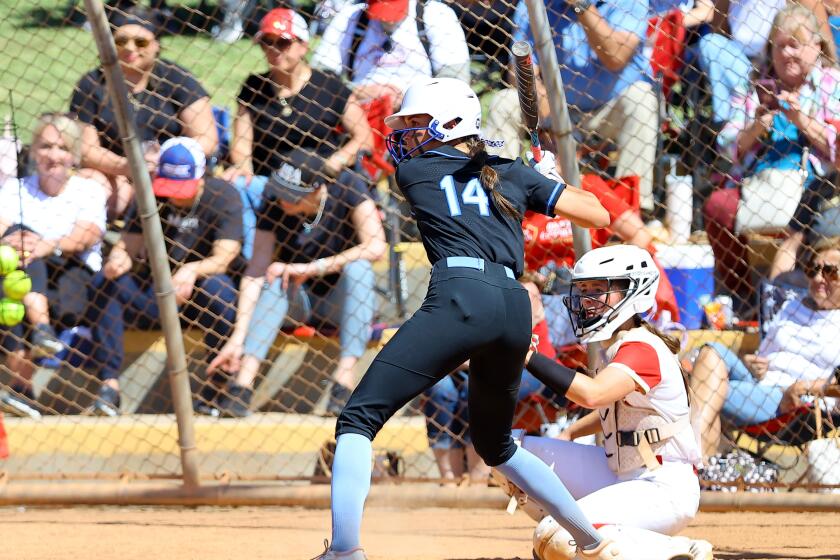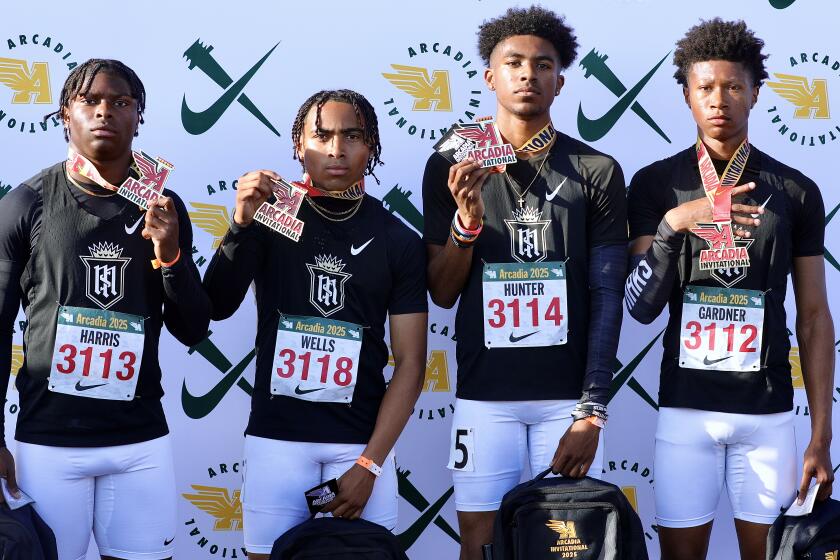Running the pattern can pay off
- Share via
INDIANAPOLIS — NFL talent evaluators rely on study sessions and stopwatches, medical reports and miles of videotape. And sometimes, just plain gut feelings.
They don’t lean on rules of thumb, because as soon as one is cemented in place, an exception comes along to shatter it.
Still, some patterns that have formed in recent years are hard to ignore.
A look at six trends that could influence a scout’s sixth sense:
Don’t mess with Texas
Year after year, the Longhorns are boots deep in blue-chip players, and yet their school has routinely turned out NFL duds. In the past 10 years, Texas has produced a crop of first-rounders who have either been outright busts, or have struggled mightily between flashes of promise: quarterback Vince Young, running backs Ricky Williams and Cedric Benson, tackle Mike Williams, cornerback Quentin Jammer and safety Michael Huff.
Yes, for a school that boasts 35 draft picks since 2000, there are bound to be some good ones mixed in. Yet a noteworthy number of them haven’t made the impact they were expected to make.
Some scouts suggest Texas players have been so coddled throughout their football careers that they aren’t as hungry as other prospects. Interesting theory, but it might just be an NFL dry spell.
Linebacker bargain? Check out Big Ten
James Laurinaitis, an inside linebacker from Ohio State, is one of the best pure football players in the draft. He’s smart, has terrific instincts and textbook fundamentals. Still, there are concerns about his speed, so much so that he could tumble to the back half of the first round or -- gasp! -- maybe even lower.
Chad Reuter, senior analyst for NFLDraftScout.com, says it’s very possible Laurinaitis could fall out of the first round unless he runs one of his better times in the 40-yard dash, in the low 4.6-seconds range.
Laurinaitis could wind up being a steal, the way Penn State’s Paul Posluszny was in 2007 when Buffalo grabbed him in the second round. Although his promising rookie season was cut short by a broken arm, Posluszny was named the Bills’ defensive most valuable player in 2008.
No all corn-fed
farm boys anymore
Nebraska is no longer the center of the universe when it comes to top-notch offensive linemen. These days, the big men can move their feet like ballerinas, and slide out to make blocks with incredible grace. Wisconsin, Michigan, Boston College and the entire Southeastern Conference produce some great ones, and seven tackles went in the first round of last year’s draft -- none from the Big 12. (In fact, the last time a Big 12 tackle was taken on the first day of the draft was 2005, when New Orleans made Oklahoma’s Jammal Brown a first-rounder.) These are pure athletes, guys who no longer slim down to their playing weight, but build up to it. Tackles to watch in this spring’s draft are Virginia’s Eugene Monroe, Alabama’s Andre Smith, Mississippi’s Michael Oher -- the focus of Michael Lewis’ bestseller “The Blind Side” -- and Baylor’s Jason Smith.
Florida flops? There must be a catch
Gators receiver Percy Harvin has scorching speed, and he’ll need it to outrun the shaky reputation of Florida receivers in the NFL. There have been some decent ones in recent years -- Jabar Gaffney, Reche Caldwell -- but more memorable were high-round fizzlers such as Chad Jackson, Reidel Anthony, Jacquez Green and, to a somewhat lesser extent, Ike Hilliard.
In some ways, Florida receivers are victims of their college success. Because they’re so speedy, and the Gators can be so innovative on offense, defenses often choose not to press those wideouts at the line of scrimmage for fear of getting beat deep. So when Florida receivers reach the NFL, they haven’t been harassed the way other college receivers have.
“They aren’t getting bumped at the line of scrimmage, they aren’t being asked often to run across the middle, so they aren’t getting hit,” said Rob Rang, also a senior analyst for NFLDraftScout.com. “When they get to the NFL, they’re being asked to do those kind of things. That’s why they struggle.”
L.A. star doesn’t
always equal NFL star
It’s long been said that USC is the de facto NFL team in Los Angeles, and that playing in the nation’s second-largest media market helps prepare the Trojans to make the step up to the pros. But in recent years, it’s been something of a bumpy transition for a lot of those players, many of whom haven’t developed into reliable pros.
USC’s contribution to the league has been a mixed bag lately, with some good pros in Carson Palmer, Lofa Tatupu, LenDale White and Steve Smith; some huge disappointments in Mike Williams, Dwayne Jarrett and Keary Colbert; and a couple of Heisman trophy winners in Reggie Bush and Matt Leinart who have yet to live up to their pre-draft hype.
QB shoppers shouldn’t overlook big MAC
The Mid-American Conference might be college football on a smaller scale, but quarterbacks from that league have certainly had a significant effect on the NFL in recent years. For proof, look no further than the world champion Pittsburgh Steelers, whose top two quarterbacks -- Ben Roethlisberger and Byron Leftwich -- both came from MAC schools. So did Chad Pennington, who had MVP credentials this season with the Miami Dolphins.
The latest MAC daddy to watch is Ball State’s Nate Davis, a junior, who looked very good at times, even though he’s on the shorter side at just a shade under 6-2.
A peculiar twist about Davis: he wears gloves -- like Arizona Cardinals quarterback Kurt Warner -- and doesn’t grip the ball on the laces when he throws it.
Then again, what does that matter? Sometimes, rules are made to be broken.
--
More to Read
Go beyond the scoreboard
Get the latest on L.A.'s teams in the daily Sports Report newsletter.
You may occasionally receive promotional content from the Los Angeles Times.











